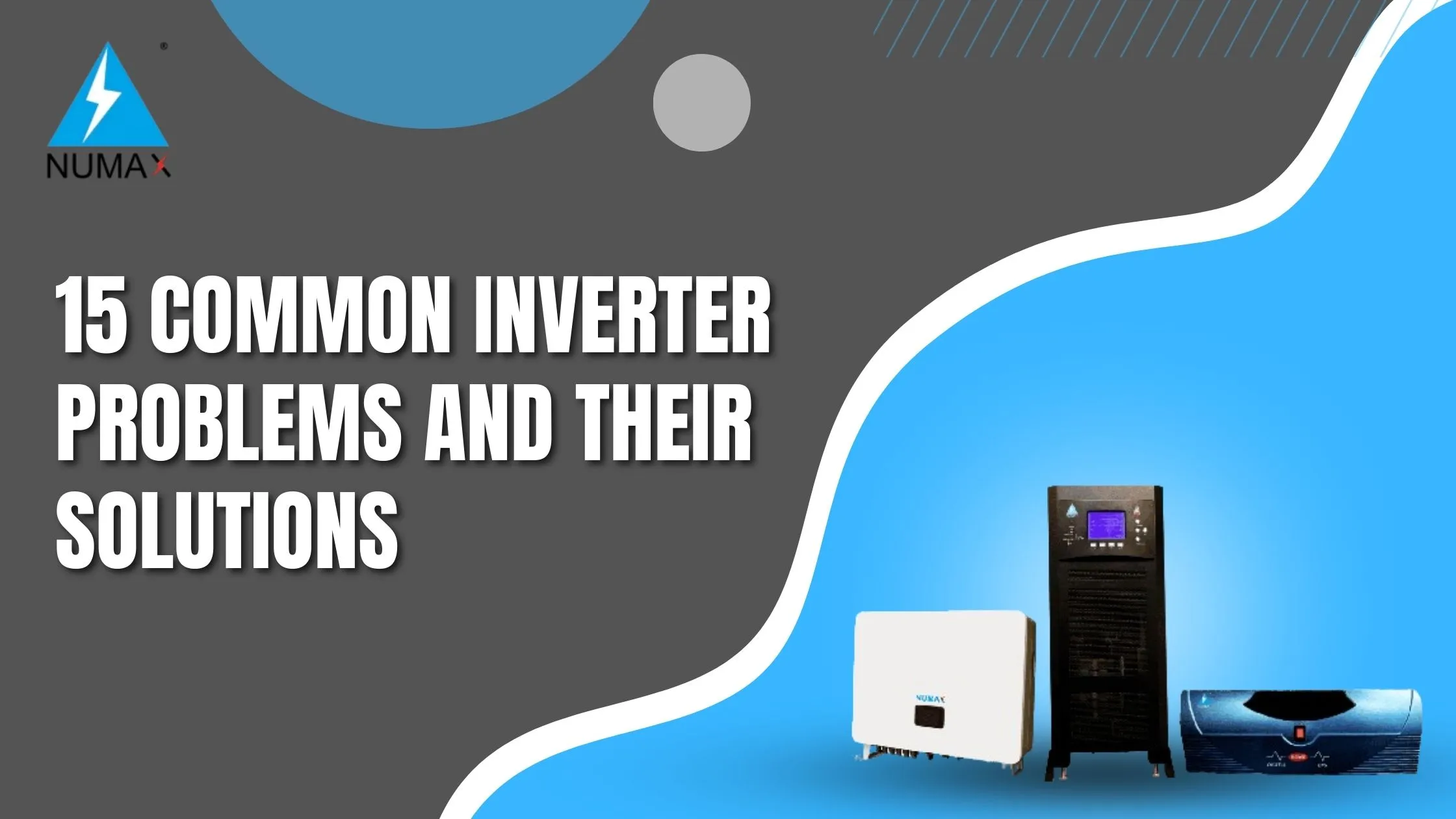
- admin
- No Comments
15 Common Inverter Problems and Their Solutions
Inverters are very useful devices that help us keep our homes and offices powered during electricity outages. They convert DC power from batteries into AC power that can run our appliances. But like any machine, inverters can sometimes have problems. This article will explain 15 common inverter problems and how to fix them. We’ll explore various inverter problems and solutions to help you understand and address these issues easily. By learning about these inverter solutions, you’ll be better equipped to handle any difficulties that may arise with your inverter system.
Whether you’re dealing with an inverter low battery problem, an inverter overload problem, or any other common issue, this guide will provide you with practical inverter solutions to keep your power backup system running smoothly. Let’s dive into the 15 most common inverter problems and solutions you might encounter:
15 Common Inverter Problems and how to fix them
1. Inverter low battery problem

This is when your inverter’s battery doesn’t have enough charge to power your devices.
Causes:
- The battery is old and can’t hold charge well anymore
- You’re using too many appliances and draining the battery quickly
- The battery isn’t getting charged properly
Solutions:
- Check if your battery is more than 3-5 years old. If so, it might be time to replace it.
- Use fewer appliances when on inverter power to save battery life
- Make sure the battery is connected properly and getting charged when main power is on
- Clean the battery terminals if they look dirty or rusty
2. Inverter overload problem

This happens when you try to run too many devices on your inverter at once.
Causes:
- Connecting more appliances than your inverter can handle
- Using high-power devices like air conditioners or water heaters on inverter power
Solutions:
- Check your inverter’s capacity and don’t exceed it
- Unplug some devices to reduce the load
- Avoid using heavy appliances on inverter power
- Consider upgrading to a higher capacity inverter if needed
3. Inverter not turning on

Sometimes your inverter might not start at all when the power goes out.
Causes:
- Loose or disconnected wires
- Blown fuse
- Faulty power switch
Solutions:
- Check all connections and make sure they’re tight
- Look for any blown fuses and replace them
- If the power switch seems broken, get it checked by a professional
4. Inverter making unusual noises
Strange sounds from your inverter can be a sign of trouble.
Causes:
- Loose internal parts
- Fan problems
- Overloading
Solutions:
- If you hear rattling, tighten any loose external screws
- Clean the fan if it’s making grinding noises
- Reduce the load if the inverter sounds strained
- If weird noises continue, call a technician
5. Inverter showing error codes

Many inverters have displays that show error codes when there’s a problem.
Causes:
- Various issues depending on the specific error code
Solutions:
- Check your inverter’s manual to understand what the error code means
- Follow the manual’s instructions for that error
- If you can’t solve it, call customer support or a technician
6. Inverter battery not charging
Sometimes the battery doesn’t charge even when main power is on.
Causes:
- Loose connections
- Faulty charger
- Battery has reached end of life
Solutions:
- Check and tighten all battery connections
- Test the charger to see if it’s working
- If the battery is very old, it might need replacement
7. Inverter shutting off frequently
If your inverter keeps turning off on its own, there’s likely a problem.
Causes:
- Overheating
- Overloading
- Low battery voltage
Solutions:
- Make sure the inverter has good ventilation
- Reduce the number of devices you’re using
- Check if the battery is holding charge properly
8. Inverter giving less backup time

You might notice your inverter doesn’t power devices as long as it used to.
Causes:
- Battery getting old
- Using more devices than before
- Battery not fully charging
Solutions:
If the battery is old, consider replacing it
Use fewer devices to extend backup time
Make sure the battery gets fully charged when main power is on
9. Inverter display not working
Sometimes the inverter’s screen might go blank or show wrong information.
Causes:
- Loose display connection
- Faulty display unit
- Software glitch
Solutions:
- Check if the display cable is properly connected
- Try resetting the inverter by turning it off and on
- If the problem persists, the display might need replacement
10. Inverter making a buzzing sound

A constant buzzing noise from your inverter can be annoying and might indicate a problem.
Causes:
- Loose transformer laminations
- Overloading
- Fan issues
Solutions:
- If it’s a new inverter, some buzzing is normal and might reduce over time
- Check if you’re overloading the inverter and reduce the load if needed
- Make sure the cooling fan is working properly
- If the buzzing is very loud or doesn’t stop, call a technician
11. Inverter tripping circuit breakers
Sometimes, your home’s circuit breakers might trip when the inverter is running.
Causes:
- Inverter output is too high for your home’s wiring
- Faulty circuit breaker
- Short circuit in connected appliances
Solutions:
- Check if your inverter’s output matches your home’s electrical system
- Have an electrician inspect your circuit breakers
- Disconnect appliances one by one to identify if any are causing the problem
- Consider upgrading your home’s wiring if it’s old
12. Inverter producing unstable voltage
This problem can cause lights to flicker or appliances to work poorly.
Causes:
- Inverter’s voltage regulation system is faulty
- Battery issues
- Overloading
Solutions:
- Check if you’re overloading the inverter and reduce the load if needed
- Test the battery to ensure it’s providing stable power
- If the problem persists, the inverter might need professional repair
13. Inverter not switching to battery power
Sometimes, the inverter fails to switch to battery power when the main electricity goes out.
Causes:
- Faulty transfer switch
- Loose connections
- Control board issues
Solutions:
- Check all connections between the mains, inverter, and battery
- Clean any corroded terminals
- If the problem continues, the transfer switch or control board might need replacement by a professional
14. Inverter producing a humming sound from connected appliances
You might hear a humming noise from fans, lights, or other devices when running on inverter power.
Causes:
- The inverter is producing “modified sine wave” instead of “pure sine wave” output
- Incompatibility between the inverter and certain appliances
Solutions:
- Some humming is normal with modified sine wave inverters
- Consider upgrading to a pure sine wave inverter for sensitive electronics
- Use a power conditioner between the inverter and sensitive appliances
15. Inverter battery swelling
If you notice your inverter’s battery looking swollen or bloated, this is a serious problem.
Causes:
- Overcharging
- Battery reaching end of life
- Manufacturing defect
- Exposure to high temperatures
Solutions:
- Stop using the battery immediately as it can be dangerous
- Disconnect the battery from the inverter
- Do not try to charge or use the swollen battery
- Replace the battery with a new one
- Ensure proper charging settings on your inverter to prevent future issues
Conclusion
Understanding common inverter problems and solutions can help you maintain your device effectively. From addressing the inverter low battery problem to managing the inverter overload problem, many issues can be resolved with simple steps. Regular maintenance and proper usage can prevent many inverter problems. Remember, when in doubt about any inverter solutions, it’s always best to consult a professional.
FAQs
Most inverter batteries last 3-5 years with proper care. Replace them when you notice significantly reduced backup time.
It depends on your inverter’s capacity. Most home inverters can’t handle the high power needs of air conditioners.
Beeping usually indicates low battery, overloading, or other issues. Check your manual to understand what different beep patterns mean.
Avoid deep discharges, don’t overload the inverter, and make sure it’s charged regularly.
Remember, if you’re ever unsure about how to handle an inverter problem, it’s always safest to consult a professional. Regular maintenance and proper use can help prevent many common inverter problems and solutions.
Most UPS batteries last 3-5 years. However, this can vary based on usage and environmental factors. Many UPS systems have indicators to let you know when the battery needs replacing.

Leave A Comment